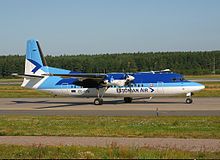Estonian Air
[12][13] The short-term aim of the government is to become a leading shareholder and to invest in the company to ensure its future, as Estonian Air is strategically important to the state.[14][15] The agreement with SAS Scandinavian Airlines was signed on 10 September 2010[16] and it took effect on 27 October 2010 when the Estonian Parliament ratified the 2010 state budget modifications, allocating needed funds for investment.In November 2011, Minister of Economic Affairs Juhan Parts proposed that SAS should follow the state's lead in making substantial investments in Estonian Air.SAS Vice-President Sture Stolen however said that this is unlikely: "We have a good and important partnership with them, but it is not our strategy to be part owners in Baltic airlines".[17] Estonian Air's new CEO and former AirBaltic chief commercial officer Tero Taskila expected the company to be profitable by 2012 after losing money since 2005.On 8 November 2015, Estonian Air ceased all operations after the European Commission declared the government funding received by the airline illegal[3] which would have forced them to pay back over €85 million.[20] As of the airline's shutdown on 8 November 2015, Estonian Air had a fleet of 6 aircraft with an average age of 8.2 years – 3 Bombardier CRJ900s, 2 CRJ700s and a single Embraer E-170.[21] On all flights there were two classes of service: Passengers holding Business or Flexible Economy fare tickets were seated in the forward sections of the one-cabin aircraft.




Tallinn AirportFrequent-flyer programEuroBonusSubsidiariesTallinnEstoniaRevenueProfitRepublic of EstoniaNordicaflag carrierairlineEuropeEstonian governmentSAS GroupEuropean CommissionEuropean UnionYakovlev Yak-40Fokker 50AeroflotBoeing 737-500Boeing 737-500sSovietFokker 50sViennaSaab 340sKuressaareStockholmHelsinkiVilniusSaint PetersburgMunichEstonian Prime MinisterAndrus AnsipTallinkFrankfurtSimferopolAmsterdamBerlinSt. PeterburgBoeing 737-300TrondheimHannoverMoscowSAS Scandinavian AirlinesEstonian ParliamentJuhan PartsScandinaviaNordic Aviation GroupAdria AirwaysBombardier CRJ900sCRJ700sEmbraer E-170Tupolev Tu-134Antonov An-2Aeroflot'sTupolev Tu-134ASaab 340Bombardier CRJ900NGATR 42-500buy on boardFlight InternationalPostimeesWayback MachineFlyestMarabuNyxAirSmartLynx Airlines EstoniaAirestAero AirlinesAeronautAir LivoniaELK AirwaysEnimexScandinavian Airlines SAS ConnectSAS LinkSAS Ground HandlingSkyTeamStar AllianceWOW AlliancePre-1952AB AerotransportAerolíneas de BalearesAerolíneas ArgentinasAerovias GuestairBalticAir GreenlandBraathensBritish Midland InternationalCimberContinental AirlinesDanairDanish Air LinesLAN ChileLinjeflygNorwegian Air LinesRezidor Hotel GroupSAS BraathensSAS CommuterScanairSkyways ExpressSnowflakeSpanairSwedish Intercontinental AirlinesThai AirwaysWiderøeAccidents andincidents1948 Northwood mid-air collisionFlight 871Flight 933Flight 130Flight 901Flight 751Flight 347Flight 686Dash 8 landing gear incidentsSAS Frösundavik Office BuildingList of airline holding companiesMaerskAPM TerminalsMaersk DrillingMaersk LineSafmarineSvitzerHöegh Autoliners